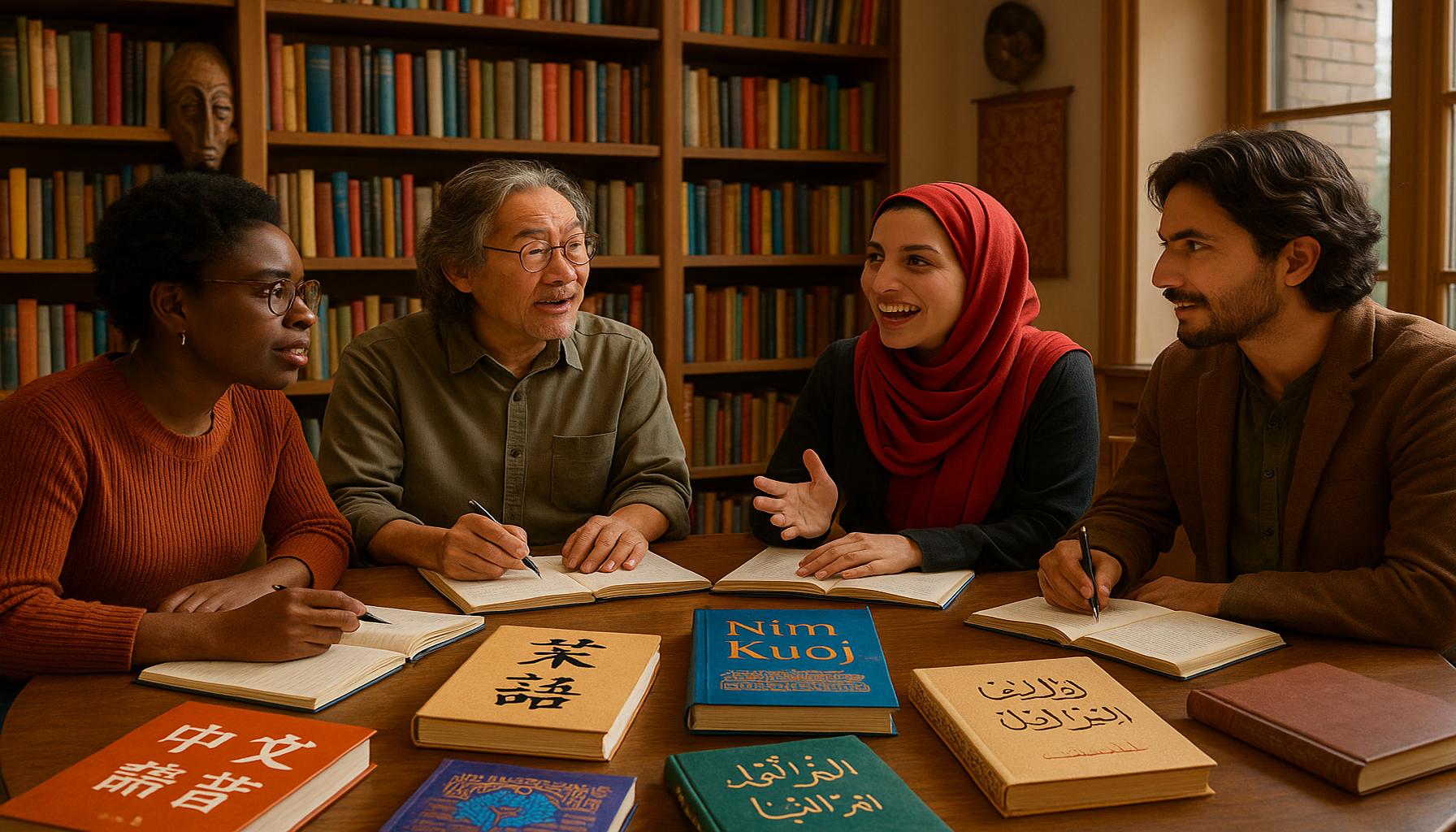Writing for Diversity: Cultural Representation in Contemporary Literature

The Importance of Diversity in Storytelling
In recent years, the call for diversity in literature has resonated throughout the literary community. Writers and readers alike are increasingly recognizing the importance of cultural representation in storytelling. As the world becomes more interconnected, the demand for narratives that reflect a variety of perspectives is stronger than ever. The rise of global connectivity has made it essential for literature to reflect the multiplicity of human experience, showcasing voices that might otherwise remain unheard.
Contemporary literature serves as a vibrant canvas where diverse voices paint unique stories. This shift in focus has led to the emergence of various themes, including:
- Identity and self-discovery – Authors such as Chimamanda Ngozi Adichie in “Americanah” provide a profound exploration of what it means to belong to multiple cultures, allowing readers to engage deeply with the complexities of identity.
- Social justice issues – In works like Angie Thomas’s “The Hate U Give,” the narrative tackles systemic inequality, police brutality, and the struggles faced by marginalized communities, encouraging readers to reflect on their own societal roles.
- Intersections of culture – Books like “The Joy Luck Club” by Amy Tan illustrate the intricate layers of cultural identity, blending Eastern and Western experiences to highlight how they influence relationships and personal growth.
These themes not only enrich the literary landscape but also foster a broader understanding of humanity. Through the lens of diverse characters and settings, readers can engage with stories that challenge their perceptions and encourage empathy. The ability to step into the shoes of people from varying backgrounds fosters a more nuanced and compassionate view of the world around us.
The Impact of Authentic Voices
As we delve deeper into the realm of cultural representation, it becomes essential to consider the impact of authentic voices in storytelling. Authors from underrepresented backgrounds are driving conversations about race, gender, and social class, reshaping narratives for future generations. Their stories reflect real struggles and triumphs, often highlighting the reality of life in a way that mainstream literature may overlook.
Literature has a profound power to shape societal understanding; the inclusion of diverse narratives broadens the collective worldview. This movement urges not only the publishing industry to recognize and elevate these voices but also readers to actively seek and engage with literature from different cultures. According to a survey from the Cooperative Children’s Book Center, while the percentage of children’s books by authors of color is steadily increasing, there is still a significant gap to bridge for full representation.

The significance of writing for diversity cannot be overstated, as it offers insights into how literature shapes our understanding of the world. Lifting the veil on varied experiences enhances the richness of human connections, ultimately paving the way for a more inclusive society. As readers and consumers of literature, embracing a diverse array of stories can lead to a transformative and enlightening journey, one that is essential in today’s increasingly globalized society.
DISCOVER MORE: Click here to learn about sustainable knitting
The Role of Diverse Narratives in Shaping Reader Experience
Diversity in literature extends beyond mere representation; it fosters a multilayered understanding of the human experience. The narratives crafted by writers from various cultural backgrounds bring forth stories that resonate on both personal and societal levels. By exploring themes of resilience, heritage, and social justice, these narratives enrich the reader’s experience and promote a holistic view of our shared humanity.
Confronting Stereotypes is one of the critical responsibilities of contemporary writers. Many authors aim to challenge long-held stereotypes associated with their cultural identities. For example, Celeste Ng’s “Little Fires Everywhere” intricately weaves the complexities of race, privilege, and motherhood in a predominantly white suburban setting, revealing biases that pervade both thought and action. Through characters who confront their prejudices and societal expectations, such literature not only entertains but educates, pushing readers to examine their own views and assumptions.
Furthermore, the process of storytelling itself becomes a means of empowerment for marginalized voices. Writers from diverse backgrounds are reclaiming their narratives by sharing their unique life experiences, which often provide a stark contrast to mainstream literature. Such narratives allow readers to learn about the richness of cultures, traditions, and struggles that differ from their own. For instance, works like The Kite Runner by Khaled Hosseini offer insights into Afghan culture and history, underlining the complexities of friendship, loyalty, and redemption.
- Bridging Generational Gaps: Stories of immigrant families, such as those found in “The Namesake” by Jhumpa Lahiri, explore the challenges of cultural dislocation and generational differences, creating a bridge of understanding between younger and older generations.
- Expanding Literary Canons: The incorporation of diverse voices into the literary canon challenges traditional narratives and encourages the recognition of authors from various backgrounds, thus broadening the definition of what constitutes ‘literature.’
- Fostering Empathy: By immersing readers in experiences unlike their own, diverse narratives cultivate empathy, allowing for a deeper understanding of social issues that may seem distant or abstract.
The embrace of diverse narratives creates a ripple effect across the literary landscape. Not only do they engage readers’ minds, but they also prompt audiences to reconsider their roles in society. These stories inspire meaningful conversations about identity, culture, and injustice, urging readers to reflect upon their position within these dialogues. As literature evolves, it is essential for both writers and readers to continue advocating for cultural representation, ensuring that stories from all walks of life are told and heard.
| Advantage | Impact |
|---|---|
| Broadening Perspectives | Encourages empathy and understanding among readers, fostering a more inclusive society. |
| Amplifying Voices | Offers platforms for marginalized authors to share their stories and cultural experiences, diversifying literary narratives. |
The theme “Writing for Diversity: Cultural Representation in Contemporary Literature” encapsulates a transformative movement towards inclusion and authenticity in storytelling. As literature reflects our society, a diverse array of voices not only broadens the readership’s perspective but also enhances the emotional resonance of narratives. When authors from varied backgrounds share their experiences, they create characters and plots that resonate with a broader audience.Furthermore, amplifying these voices enables readers to encounter narratives previously overshadowed by mainstream literature. As a result, readers are exposed to rich cultural landscapes and the complexities of human experience—encouraging a profound sense of empathy and understanding. Engaging with literature that represents diverse cultures paves the way for greater social awareness, urging a reevaluation of stereotypes and biases within our communities. As this dialogue continues, the landscape of contemporary literature evolves, making it essential to explore these themes further.
DISCOVER MORE: Click here to learn about the benefits of art therapy
The Impact of Inclusive Storytelling on Society
As the landscape of contemporary literature continues to evolve, the influence of inclusive storytelling on society cannot be understated. Writers from diverse backgrounds contribute their unique perspectives, crafting narratives that play a fundamental role in shaping cultural discourse. As stories cross geographical and cultural boundaries, they create a dialogue that celebrates differences while highlighting common experiences.
One of the most profound outcomes of culturally representative literature is the creation of role models for young readers. Literature that features characters from a variety of cultural backgrounds not only affirms the identities of those who share those backgrounds but also serves as a source of inspiration for others. Books like Children of Blood and Bone by Tomi Adeyemi engage readers with fantasy worlds steeped in West African culture, empowering young readers to envision themselves as heroes in their own right. This phenomenon encourages the next generation to embrace their uniqueness while fostering a sense of belonging.
Additionally, the exploration of intersectionality within literature allows for a more nuanced approach to understanding identity. Works like The Underground Railroad by Colson Whitehead delve into the intersection of race, gender, and history, revealing how these factors influence individual experiences. By utilizing literary tools to dissect complex social issues, such narratives push readers to reevaluate their perspectives on privilege and marginalization, challenging them to think critically about systemic inequalities.
- Encouraging Aspiring Writers: As diverse stories receive recognition in literary awards and bestseller lists, they inspire aspiring writers from similar backgrounds to share their own narratives. This burgeoning enthusiasm for storytelling corresponds with a broader cultural push for representation in media.
- Amplifying Diverse Voices in Publishing: The rise of independent publishing houses dedicated to amplifying underrepresented voices is significant. Publishers like Amistad and Lee & Low Books are committed to elevating diverse narratives, thus directly influencing what content reaches audiences.
- Enhancing Educational Curricula: The incorporation of literature featuring diverse perspectives in school curricula can expand students’ worldviews. Programs that emphasize multicultural literature, such as those advocated by organizations like the National Council of Teachers of English, aim to equip students with the cultural competence necessary for our increasingly diverse society.
The ongoing demand for diverse literary representation not only enriches the literary canon but also challenges society to confront its biases and assumptions. As readers delve into the intricate tapestries of different cultures, they cultivate a broader understanding of the world, which can lead to meaningful change on individual and collective levels. In this context, literature serves as a powerful tool for social transformation, encouraging dialogue, understanding, and empathy across cultural divides.
DISCOVER MORE: Click here to find out how knitting can ease your stress
Conclusion: Embracing the Tapestry of Diversity in Literature
In conclusion, the importance of written diversity in contemporary literature cannot be overstated. By embracing cultural representation, writers open doors to new universes and perspectives that encourage readers to explore the rich tapestry of the human experience. This commitment to inclusivity not only enriches the literary landscape but also instigates a broader societal dialogue about identity, belonging, and the interplay of culture.
As we navigate this era of growing awareness around intersectionality and representation, the need for authentic voices has never been more critical. The power of narrative enables us to empathize with others and challenges our preconceived notions, paving the way for social change. Initiatives that support diverse authors and advocate for multicultural literature in education nurture an environment where all voices can thrive, ultimately contributing to a more equitable industry.
Moreover, the ripple effects of inclusive storytelling reach beyond mere entertainment; they foster understanding among audiences of all backgrounds. Parents, educators, and writers among us must prioritize this push for diversity, ensuring that future generations inherit a literary world alive with varied experiences and visions. Thus, in our quest for a more inclusive narrative, we not only honor those represented but collectively help craft a more empathetic future.
As literature continues to evolve in response to societal needs, we must actively seek out and celebrate diverse narratives, acknowledging their capacity to transform perceptions and enlighten minds. By championing the voices that have long been silenced, we not only enrich our understanding of the world but also contribute to a legacy rooted in acceptance, empathy, and shared humanity.



